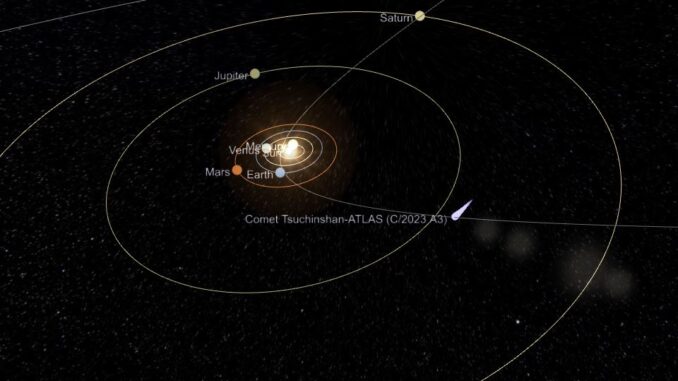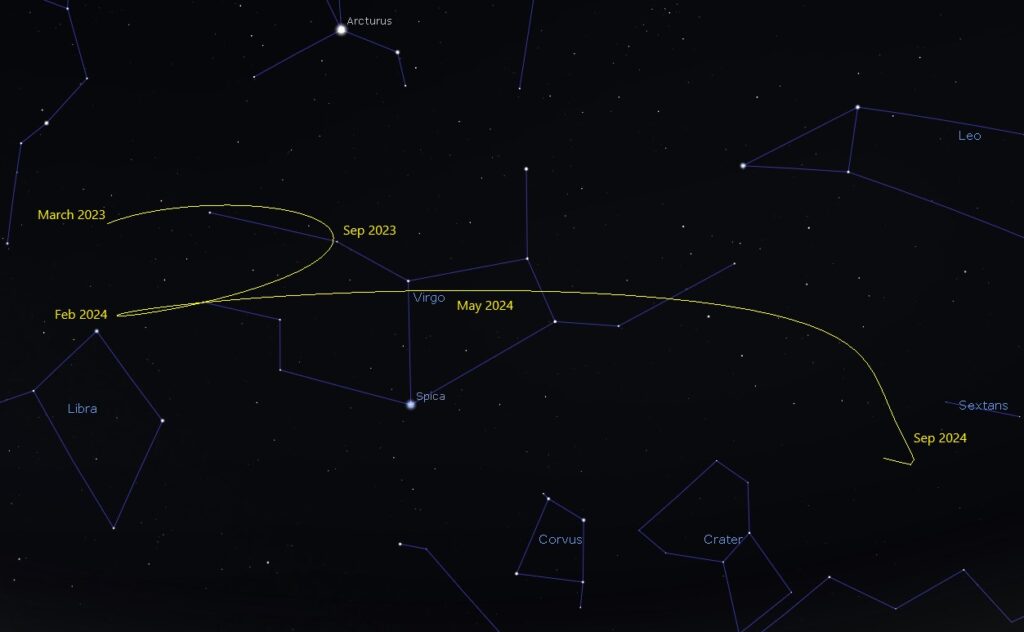
A new comet, designated as C/2023 A3 (Tsuchinshan-ATLAS), was discovered by the ATLAS survey in Hawaii on February 22, 2023. The object was also independently found in images by the Purple Mountain Observatory (Zijin Shin or Tsuchinshan) taken on 9 January 2023. It was was subsequently detected in images taken by Zwicky Transient Facility (ZTF) in the Palomar Observatory on 22 December 2022
It is thought that this long-period comet takes around 80,000 years to orbit the Sun . This means that the structure of the icy object has remained dormant for tens of thousands of years in the extreme cold of the cosmos.
Currently, C/2023 A3 is located about 7 astronomical units (AU) away from the sun but as it gets closer, it will begin to release gas and dust, creating a coma around the nucleus that will reflect sunlight and make the comet visible from Earth.
Observations of the comet show a fuzzy ball of light surrounded by a faint halo, which is the beginning of the coma forming around the nucleus. As the comet moves closer to the sun, the coma is expected to become larger and more visible.
Where is the comet now ?
Comet C/2023 A3 is currently between the orbits of Saturn and Jupiter and visually positioned in the constellation of Serpens at magnitude 18.
The object will gradually move eastward in to the constellation of Virgo through 2023. It is expected to make its closest approach to the sun in September 2024, at which point it may become visible to the naked eye from Earth.
Comet C/2023 A3 Finder Chart for 2023-2024

How bright will Comet C/2023 A3 (Tsuchinshan-ATLAS) get ?
Current predictions suggest that Comet C/2023 A3 may become a particularly bright in the night sky, with an estimated peak brightness of around magnitude 0 (or even brighter). This would make it easily visible to the naked eye and potentially even outshine some of the brightest stars in the sky.
As the comet gets closer to the sun, it will heat up and release more of the gas and dust that has been locked inside the icy structure for tens of thousands of years. This will create a larger and brighter coma and could subsequently produce a spectacular sight in the night sky.
As with all comets, we can only make ‘best guess’ brightness predictions, especially in these early stages of the comet’s journey towards our star.
Tsuchinshan-ATLAS is predicted to have quite a close encounter with the sun with a distance of 0.39 AU (36 million miles) at perihelion on 27 September 2024. This runs the risk of breaking the comet up in the process (much like comet Ison in 2013).
Conversely, if the comet survives perihelion intact, we could be in for quite a show during closest approach to Earth 20 days later.
When is closest approach to Earth?
Comet C/2023 A3 (Tsuchinshan-ATLAS) will reach closest approach to Earth on October 13, 2024 at a safe distance of 0.47 AU (43.6 million miles).
